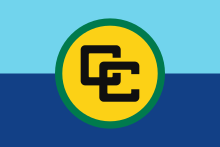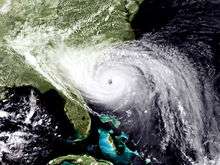Caribbean Disaster Emergency Management Agency
The Caribbean Disaster Emergency Management Agency (CDEMA)[1] is an inter-regional supportive network of independent emergency units throughout the Caribbean region. Formed on September 1, 2005 as the Caribbean Disaster Emergency Response Agency (CDERA) it underwent a name change to CDEMA in September 2009.
| This article is part of the series on |
| Politics and government of the Caribbean Community |
|---|
 |
|
|
Community Council
|
|
Other
|
Members
The participating member states and agencies of the CDEMA include:
Activities
In recent years, the role of the CDEMA has been mostly to provide disaster assistance to member countries.[2] Such roll out of CDEMA personnel was witnessed for Grenada and Jamaica in early September, 2004 after the passage of Hurricane Ivan.
During the mid-1990s, the sudden eruption by the Soufriere Hills volcano in Montserrat also caused the CDEMA to spring into action, to provide additional support to the people on the island. The Caribbean Disaster Emergency Response Agency (CDEMA) also regularly monitors the Soufriere Hills volcano, in addition to the active undersea volcano named Kick 'em Jenny to the north of Grenada.
Members of the Regional Security System have requested military and logistical assistance through that agreement after natural disasters as well.
Background
Towards the end of the twentieth century, severe weather had been increasing, especially in the Caribbean region and the Gulf of Mexico. Being able to control and minimize the damage caused by these disasters is critical to life in that part of the world. The world recognized a need to establish an organization to handle natural disasters in that region and in July 1984 the Pan-Caribbean Disasters Preparedness and Prevention Project (PCDPPP) was established. The Caribbean has battled with independence from its mother European countries for centuries and before the PCDPPP came about the traditional way of handling disasters in the area was though private donors, a method that was heavily dependent on others and failing to help their cause for independence.[3]
The creation of the PCDPPP was a collection of international sponsors such as the United States Agency for International Development (USAID), the Canadian International Development Agency, the Government of the Netherlands, and the United Nations Disaster Relief Organization (UNDRO). The PCDPPP failed to break free from the direct and indirect dependence the Caribbean had towards Europe and the United States. One significant failure of the PCDPPP was for its participants to fully take part in the organization itself and become more involved with civil society.
In 1989, with the widespread destruction of Hurricane Hugo, a response for a more effective form of natural disaster management and preparedness was recognized. In 1991 the Caribbean Disaster and Emergency Response Agency (CDERA) was created.[4] The Caribbean was moving towards the independence it desired. CDERA was formed with 16 participating Caribbean nations. This way the Caribbean countries had regional support along with international support. Aid from regional sources was now becoming more of a possibility. CDERA would later take a name change to encompass their end goal of not only responding to disasters but managing all types of disasters. Later in the first decade of the twenty first century CDERA became CDEMA, the Caribbean Disaster Emergency Management Agency.
History

In 1989, when the PCDPPP was beginning to fall apart Hurricane Hugo struck the Caribbean. Relief was still relying on foreign aid from countries such as the United States. By 1990 the insurance companies were criticizing the PCDPPP and how it was necessary to revamp the system in which the Caribbean responding to natural disasters. The construction industry in particular was criticized for not enforcing enough standards in structure’s abilities to withstand disasters prone to the Caribbean.[5] In 1991 the PCDPPP ceased to exist and for about a month the insurance agencies in the region were desperate for a replacement.[6] In terms of disaster relief and management the Caribbean region was in limbo awaiting a strong force to aid them in a time of crisis. There were little signs of funding for the formation of such an organization and meeting the deadline of June 1, 1991 of the implementation of a new disaster relief organization was looking doubtful.[7] Funding was and still is a huge part of this region and in terms of disaster relief meant everything. The Caribbean Community (CARICOM) was finally able to take the initiative and set up CDERA in September 1991.[8]
The growth of CDERA is said to have been very slow throughout the 1990s.[9] Things began to improve starting in the twenty first century with CDERA. In 2003 studies showed how their own developed earlier warning systems in the Caribbean straight from the Caribbean Metrological Organization based in Trinidad and Tobago were reducing the lives loss in disasters. There was still controversy over whether the people had confidence in this system and they needed to study how the public interacted with these systems for improvement.[10]
In 2005, CDERA was planning to better coordinate with the tourism industry and get them up to speed on preparing a response strategy and a clear plan for preparing for natural or man-made disasters. CDERA was also formulating plans to better train their employees and improve the spread of information. The Caribbean Tourism Organization (CTO) claimed the current system CDERA was using needed to become more united into one system instead of a “tower of Babel” effect occurring.[11] Also later that year CDERA coordinator, Jeremy Collymore, started putting pressure on the individual countries of the Caribbean Union to increase their preparedness plan, giving them encouragement to become more self sustainable in case of an emergency. While encouraging strengthening from within, aid from Japan was used to help develop their community early warning systems and hazard management ability.[12] With the recent tsunamis in Thailand and Somalia aid was sought from the Pacific Tsunami Warning Center to develop earlier tsunami warning systems in the Caribbean. Although CDERA was looking outward for nations with experience in tsunamis, much studying was done on the subject within the Caribbean at places such as the University of Puerto Rico, the University of the Virgin Islands.[13]
In 2006, financial aid from the European Commission granted 3.4 million to help prepare for disasters. CDERA was responsible for using this money where they saw fit. Financing CDERA’s projects is still continuing to be greatly funded from outside sources.[14] Even today approximately 90% of funding for CDERA’s projects comes from international donors.[15] Along with funds being heavily dependent on foreign sources staffing for CDERA has been in serious trouble. It has been said that some staff members of CDERA lack backgrounds in disaster management and those in charge are low in the bureaucracy’s chain of command.[16]
In 2010, CDERA has undergone a name change to the Caribbean Disaster Emergency Management Agency (CDEMA).[17] CDEMA is still constantly trying to increase their effectiveness in disaster managing while keeping it sustainable within their own region. They have recently been focusing on creating a better connection with policy makers and technical officials for better results.[18] CDEMA has evolved a lot since its creation in 1991 and taken a largely more independent role of disaster relief for the Caribbean. It provides a local response effort and management system to handle the increase of natural disaster in the recent few decades. CDEMA still largely leans on foreign aid for its financial support. CDEMA continues to grow into a strong local agency to manage and respond to disaster is the Caribbean region. These agencies however may not be effective in responding to Caribbean countries during a threat posed by a natural disaster.
See also
References
- "CDERA prepares for change in name, mandate". Barbados Advocate. Archived from the original on 2012-02-15. Retrieved 2009-05-14.
- "About Us - CDEMA". www.cdema.org. Retrieved 2019-04-02.
- Thompson, Denise D.P. (May 2010). Building Effectiveness in Multi-State Disaster Management Systems: The Case of the Caribbean Disaster and Emergency Response Agency (PDF) (PhD). Pennsylvania State University. p. 27. UMI Number: 33420294. Retrieved January 23, 2017.
- Leonard James Huggins “Comprehensive Disaster Management and Development: The Role of Geoinformatics and Geo-Collaboration in Linking Mitigation and Disaster Recovery in the Eastern Caribbean.” (PhD. Diss., MPPM, University of Pittsburgh, 2007), 7-8.
- “Insurance risk management strategies ‘need to improve’” Lloyd’s List International (November 1, 1990)
- “Caribbean alarm at loss of back up risk management from United Nations PCDPPP,” Lloyd’s List International (May 21, 1991)
- “Caribbean alarm at loss of back up risk management from United Nations PCDPPP,” Lloyd’s List International (May 21, 1991)
- Denise D.P. Thompson “Building Effectiveness in Multi-State Disaster Management Systems: The Case of the Caribbean Disaster and Emergency Response Agency.” (PhD diss., Pennsylvania State University, 2010), 26
- Leonard James Huggins “Comprehensive Disaster Management and Development: The Role of Geoinformatics and Geo-Collaboration in Linking Mitigation and Disaster Recovery in the Eastern Caribbean.” (PhD. Diss., MPPM, University of Pittsburgh, 2007).
- “Caribbean: Disaster-response agency urges increased preparedness for disasters,” BBC Monitoring Americas (February 1, 2005): www.cananews.net
- “Caribbean tourism industry draws up new disaster-response plan,” BBC Monitoring Americas (November 7, 2005): www.cananews.net
- “Caribbean: Disaster response agency coordinator views early warning systems,” BBC Monitoring Americas (November 12, 2003): www.cananews.net
- “Caribbean seeking to develop early tsunami warning system,” Caribbean Today (January 2005)
- “EU approve grant to improve Caribbean disaster preparedness,” BBC Monitoring Americas. (September 15, 2006): www.cananews.net
- Denise D.P. Thompson “Building Effectiveness in Multi-State Disaster Management Systems: The Case of the Caribbean Disaster and Emergency Response Agency.” (PhD diss., Pennsylvania State University, 2010), 52.
- Denise D.P. Thompson “Building Effectiveness in Multi-State Disaster Management Systems: The Case of the Caribbean Disaster and Emergency Response Agency.” (PhD diss., Pennsylvania State University, 2010), 44.
- Denise D.P. Thompson “Building Effectiveness in Multi-State Disaster Management Systems: The Case of the Caribbean Disaster and Emergency Response Agency.” (PhD diss., Pennsylvania State University, 2010), 44..
- “Effective Disaster Management addressed at recent CDEMA meeting,” BVI News (May 31, 2011): www.bvinews.com